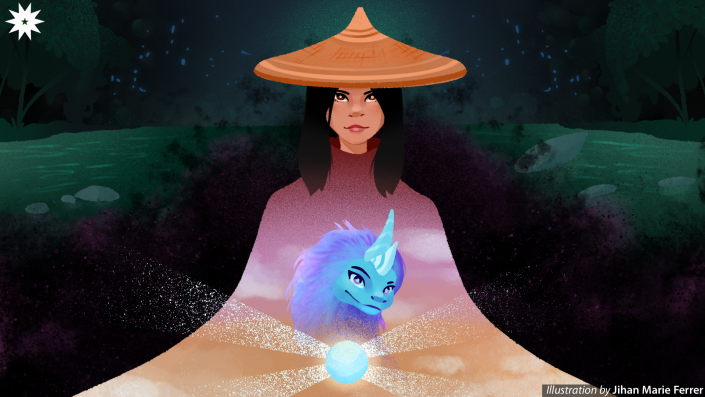Disney has built an empire on fond childhood memories. Through a colorful array of supernatural beings, princesses, and anthropomorphic toys and vehicles, the studio has imparted endearing life lessons to kids across generations. Now, Disney is expanding their fictional universe to a reimagined ancient Southeast Asia with Raya and The Last Dragon.
The film arrived with much fanfare to the studio’s streaming platform Disney+ last March 5. With its Asian-centric plot and cast, Raya was heralded as a promising start for more Asian representation on screen. However, Disney’s track record in handling representation in previous tentpole projects like Mulan (2020) and Aladdin (2019) did little to assuage doubts. With more and more studios jumping in on the trend of inclusivity, an even bigger question is raised in the wake of Disney’s latest attempt—what does it mean to be truly represented?

Another one for the books
While Disney prides itself for innovative animated content, it is undeniable that the studio has been milking a particular cow for a while now. For all its talk about groundbreaking representation, Raya and The Last Dragon doesn’t really stray away from Disney’s reliable formula. We’ve seen this film before—headstrong female protagonist is born into a family of influence and finds herself in a life-changing journey to resolve a conflict that threatens everything she holds dear with a loyal and merchandise-friendly sidekick by her side (Moana, Frozen, Tangled, Brave).
Despite recycling such formula, one would expect a modicum of imaginative storytelling from the film’s directors Dom Hall and Carl López Estrada and producer Osnat Shurer, who disclosed that they formed a team of anthropological consultants called the Southeast Asia Story Trust to ensure the film brings truth to what its supposed to represent. However, the story fails to delve deep into its rich source material and takes a turn into all-too-familiar territory. Ultimately, Raya and the Last Dragon ends up feeling like a story about Asian culture written for Western audiences.
The tip of the iceberg
Disney never disappoints with their trademark animation and Raya is no different, delivering vibrant visuals that will surely satisfy kids and kids at heart. Aside from the fact that Sisu (Awkwafina) resembles a My Little Pony character more than a mythological creature, the visuals blend well with the masterfully orchestral soundtrack by James Newton Howard. One can hear variations of soft beats and howls from synthetic instruments, something that is not commonly found in the score of an animated Disney film. But it works because it delivers an adrenaline kick that inspires a yearning for adventure, complemented by the beating percussion and chimes of familiar traditional Southeast Asian musical instruments that bring the action-packed experience full circle.
While Raya is a unique addition to the roster of Disney heroines children will look up to, her character, voiced by Kelly Marie Tran, could’ve been given more nuance than being a mere combination of Merida’s valor and Moana’s heritage-driven story. Adding a pop of color to Raya’s grim demeanor is the last dragon herself, Sisu. Serving as the comic relief throughout the film, she’s depicted as a liberal and uncultured dragon with a Blaccent—something Awkwafina has long been criticized for. This imposition of Western-centric lens also extends to the depiction of the different tribes and cultures of the fictional Kumandra—the presence of chiefs, pickpockets, assassins display stereotypical identities of Asians imposed by the West. While there’s nothing wrong with providing a fresh perspective on Asian cultural symbols, one mustn’t settle with portraying them through Western lens and instead depict them in accordance with their culture of origin. The film’s cast is also notably devoid of actual Southeast Asian actors with Disney choosing to cast already-established East Asian names like Gemma Chan and Sandra Oh. The film’s frustrating attempt to tick all boxes in a representation checklist to incorporate everything from everywhere ends up being a disservice—and alien—to the people it wanted to recognize.
A confusing mix of cultures
Telling a story about Southeast Asia by tossing all of its cultures and traits into a figurative blender undermines the very purpose of making a film that represents culture. It leaves out the rich cohesiveness unique to specific aspects of a culture, such as those that bind art, music, and cuisine into traditions and celebrations. Instead, it selects desirable elements as if in a cultural buffet and creates a deceiving monolithic pretense that all these cultures can just be unceremoniously lumped in together.
Large studios like Disney have the power to send messages through their work. Unfortunately, the narrative they choose to send time and again falls short of authenticity. Beyond the visually stunning animation, there is still a long way to go before authentic representation of these cultures. Much is still left to be desired in doing away with dialogue and story choices that exist solely for the relatability factor of Western audiences at the expense of the rich cultural heritage of an underrepresented people.
While Raya and The Last Dragon serves baby steps to inspire other film and animation studios to do better cultural representation in an industry long plagued by a lack of it, it goes without saying that cultures are intangible parts of the identity of a community. To misrepresent a culture is the same as misrepresenting their identity, and how the rest of the world will come to view and understand them and their culture. The gravitas of cultural representation should not end at merely acknowledging that these cultures exist, but should extend to recognize the people that these cultures represent—their history, livelihood, and ingenuity that cement their place in the world.
Rating: 2.5
